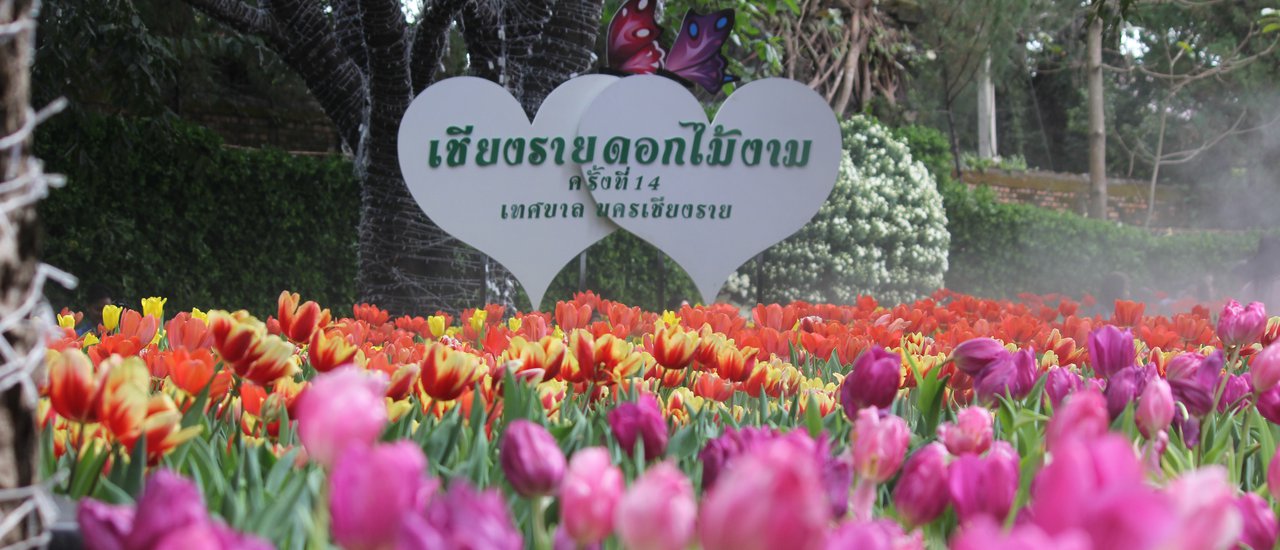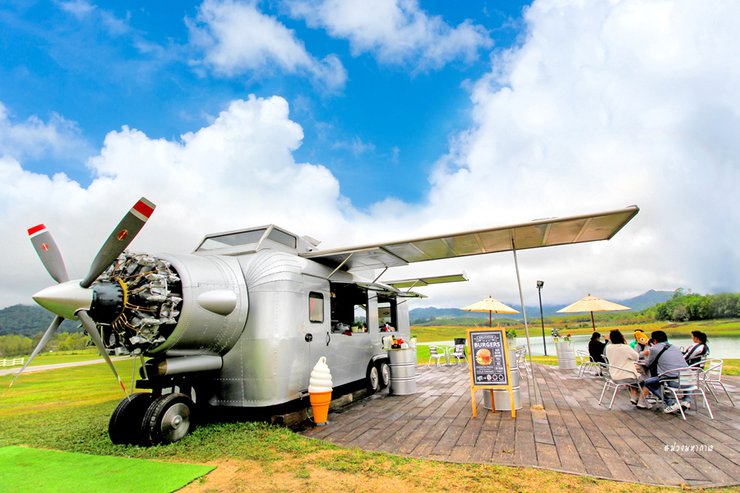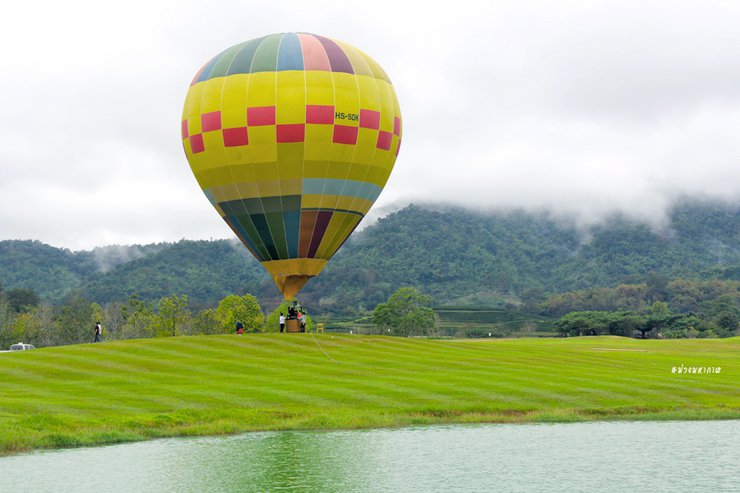Chiang Rai: A Winter Wonderland in Northern Thailand
Nestled in the northernmost reaches of Thailand, Chiang Rai beckons travelers with its captivating charm, especially during the winter months. This enchanting province boasts a tapestry of vibrant experiences, from blooming winter flowers and ethereal morning mist blanketing mountain peaks to the tantalizing flavors of local cuisine and the melodious tunes of traditional instruments.
Chiang Rai's allure lies in its ability to transport visitors to a realm of serenity and cultural immersion. The province's rich Lanna heritage is evident in its intricate temples, vibrant festivals, and the warm hospitality of its people.
Whether seeking adventure amidst breathtaking landscapes, indulging in culinary delights, or delving into the depths of cultural traditions, Chiang Rai offers an unforgettable winter escape.
This section of the travelogue focuses on tourist attractions within Chiang Rai city and its immediate surroundings, including Mae Yao sub-district. Although located within Mueang district, Mae Yao boasts a wealth of mountains, natural attractions, tribal stories, and fascinating riverside life along the Kok River.

Another travel destination in my style, Purple Mahakaal LIFE FOR TRAVEL https://www.facebook.com/PEESAT.PANTIP
Before heading to the city, I couldn't resist going up to Doi. It's the cold season, and I wanted to admire the sea of fog. Uncle Muang traveled to Doi Pha Tang, Wiang Kaen District, Chiang Rai. But he was disappointed because the weather today was not cooperating. The fog was so thick that he couldn't see anything. The picture shows the viewpoint "Pha Bong", the love gate of the mountains at Doi Pha Tang. It is said that if lovers hold hands and walk through the love gate of the mountains here, their love will last forever.

Sometimes, the unexpected brings unexpected rewards, like the sea of mist at Goodview@Phu Chi Fa. The mist flowed over to our tent, even though we didn't find any at Doi Pha Tang. It seems the mist found us at our tent instead.

Nestled amidst the breathtaking scenery of Phu Chi Fa, Goodview offers a tranquil retreat for nature enthusiasts. This intimate resort boasts a limited number of cozy cabins, prioritizing the unique experience of tent camping. The highlight of Goodview lies in its abundance of well-appointed bathrooms, ensuring a comfortable stay for all guests. Moreover, with a stroke of luck, visitors may be treated to the mesmerizing spectacle of a sea of mist enveloping the resort, creating an unforgettable encounter with nature's wonders.

This morning, we traveled north to Chiang Saen district in Chiang Rai province. Our destination was Doi Sa Ngo.

Doi Sa Ngo: A Challenging Climb with Rewarding Views
Doi Sa Ngo, located approximately 16 kilometers from Chiang Saen District Office, offers a scenic destination with a moderate level of difficulty in terms of accessibility. While the majority of the journey is manageable, the final 500 meters present a significant challenge, requiring a four-wheel drive vehicle due to the rugged terrain and deep potholes.
For those without a suitable vehicle, local residents offer transportation services for a reasonable fee of 100 baht per car, accommodating up to seven passengers. Visitors are required to park their vehicles within the village parking lot for a fee of 50 baht.

The highlight of this location is the panoramic viewpoint offering a breathtaking view of three countries: Myanmar, Laos, and Thailand. Visitors can also experience the unique lifestyle of the Akha hill tribe residing in the area. If you're lucky, you might even witness a mesmerizing sea of fog enveloping the surroundings.

Nestled amidst the scenic landscapes of Doi Sa Ngo, this destination offers a range of amenities to cater to the needs of discerning travelers. From cozy cabins that provide a rustic retreat to designated camping areas, visitors can choose their preferred accommodation option. Moreover, a selection of delectable culinary delights is available to tantalize the taste buds, ensuring a truly satisfying experience.

This afternoon, we returned to Chiang Rai city to soak up the winter atmosphere at Singha Park. If you're looking for a vacation that offers a complete range of experiences, this is the place to be. Not only can you admire the beauty of the flower fields, but Singha Park also offers opportunities for exercise, cycling, tram rides, hot air ballooning, ziplining, and even feeding giraffes.

Uncle Muang especially likes this corner. It is a restaurant that is decorated very cutely and is a very relaxing place to sit and rest.

Unfortunately, the cosmos flowers at Singha Park are not in full bloom today, as their season has just ended. However, a few scattered blooms can still be seen along the roadside, offering a glimpse of their beauty. The next blooming season is expected to begin in February.

Singha Park remains as beautiful as ever, adorned with a diverse array of flowers, just as it has been on every visit.

Uncle Muang spent an unusually long time here today, captivated by the beauty of the flowers and the cool, sunny weather. He strolled around, taking pictures, and thoroughly enjoyed himself.

This evening, Uncle Muang visited Wat Rong Khun, which is not far from Singha Park. The atmosphere and architecture of the temple remain as beautiful as ever. The recently expanded parking lot makes parking more convenient and reduces the walking distance.

The final image of the day captures the exquisite beauty of the White Temple, concluding the day with a sense of inner peace.

Uncle Muang had the opportunity to capture the atmosphere of the 1st Flipper Bike Championship, a collaboration between the Tourism Authority of Thailand (TAT), Flipper Bike, PJ Kisd Bike Shop, CentralPlaza Chiang Rai Shopping Center, and many other sponsors. The event provided an opportunity for children aged 2-6 years old to participate in a balance bike competition, divided into different age groups. The event took place on November 12, 2017.



The 1st Flipper Bike Championship: A Whirlwind of Fun and Excitement
The inaugural Flipper Bike Championship saw young riders take to the track, showcasing their agility and skill. With no footrests to rely on, these pint-sized racers propelled themselves forward by pushing their feet against the ground. Their nimble movements and playful maneuvers drew cheers from the sidelines, where parents, relatives, and supporters gathered to witness the spectacle. The atmosphere was electric, filled with laughter and the thrill of competition.






This morning, Uncle Muang paid his respects at the monument of King Mengrai the Great, which is located at the five-way intersection of King Mengrai. King Mengrai the Great was the first king of the Mangrai dynasty, who built the city of Chiang Rai to its former glory.

Not far from the statue of King Mengrai the Great, stands the Chiang Rai Clock Tower, a landmark that distinguishes itself from ordinary clock towers with its exquisite beauty and ability to change colors. Designed and overseen by National Artist Professor Chalermchai Kositpipat, the clock tower is a testament to the city's rich cultural heritage.

The Chiang Rai Flower Festival is located approximately 500 meters from the Clock Tower, within the Tung and Lantern Garden, which was built to commemorate the 75th anniversary of His Majesty the King's reign. This convenient location places it in close proximity to other popular tourist attractions in the city center.

The Chiang Rai Flower Festival is an annual event that showcases a stunning array of flowers. This year marks the 14th iteration of the festival, which features a variety of activities and attractions. Visitors can enjoy live music, cultural performances, and a food court. Admission to the festival is free, and it will run until February 17, 2018.

The annual Chiang Rai Flower Festival's main attraction is the vibrant display of tulips, captivating tourists from across the country to witness its beauty.

The vibrant colors of the tulips, coupled with the romantic atmosphere, soothing music, and cool air, create an unforgettable experience that should not be missed when visiting Chiang Rai during the winter season.

Approximately 3 kilometers from the Chiang Rai Flower Festival, there is another exquisitely beautiful temple, Wat Rong Suea Ten, located in Rim Kok Subdistrict, Mueang District, Chiang Rai Province.

“Wat Rong Suea Ten”, a temple renowned for its unique and exquisite artistic style, prominently features the color blue as its primary hue. The design and creation of this temple are attributed to Mr. Phutta Kabkaew, also known as "Salanok," a local Chiang Rai artist who was once a student of Ajarn Chalermchai Kositpipat.

The interior of the temple features murals depicting the life of Buddha, rendered in delicate shades of blue with intricate and graceful patterns. The magnificent white Buddha statue, known as "Phra Phuttha Ratchamongkhon Bodhi Triloknatha," serves as the main focal point.

Approximately 3 kilometers from Wat Rong Suea Ten is the Old Chiang Rai Provincial Hall, another historical site dating back over 100 years. In front of the building stands a statue of King Rama V.

Adjacent to the old City Hall is Wat Phra Singh, a first-class royal temple of the third kind, located on Tha Luang Road, Wiang Subdistrict, Mueang District, Chiang Rai Province.

The name "Wat Phra Singh" likely originates from the temple's historical role as the repository of the revered Phra Buddha Sihing, a significant national Buddha image also known colloquially as "Phra Singh." Currently, Wat Phra Singh houses a replica of the Phra Buddha Sihing in the Chiang Saen art style.

Nestled adjacent to the ordination hall housing the revered replica of Phra Buddha Sihing, stands another magnificent ordination hall, a testament to the grandeur of Lanna Thai architecture, reminiscent of the Chiang Saen era.

The principal Buddha image enshrined within the ordination hall of Wat Phra Singh is a magnificent gilded bronze statue in the Lanna Thai style, dating back to the 21st Buddhist century. The image depicts the Buddha in the Mara-Vijaya posture, signifying his triumph over the forces of temptation and evil.

A few hundred meters away is Wat Phra Kaew, another important temple in Chiang Rai province. Located on Thanon Trirat in the heart of Chiang Rai, this temple is where the Emerald Buddha, or Phra Phuttha Maha Mani Ratana Patimakorn, was discovered. The Emerald Buddha is currently enshrined at Wat Phra Kaew in Bangkok.
Upon entering, one encounters the ordination hall, built in the Chiang Saen style. It features a low base and a gently sloping roof, showcasing remarkable architectural beauty.

The interior of the ordination hall houses the Phra Chao Lan Thong, a bronze Buddha statue in the attitude of subduing Mara.

The innermost section houses the Jade Buddha Pavilion, a structure built in the ancient Lanna architectural style.

The Emerald Buddha of Chiang Rai
The Emerald Buddha enshrined within the Emerald Hall is a revered jade statue jointly created by the僧伽 and Buddhist devotees of Chiang Rai to commemorate the 90th birthday of Her Majesty Queen Sirikit. The statue was consecrated by His Majesty King Bhumibol Adulyadej at the Phra Ubosot of Wat Phra Si Rattana Satsadaram on September 20, 1991. Subsequently, the people of Chiang Rai invited the statue to be enshrined here, where it is now known as the "Emerald Buddha of Chiang Rai."

Adjacent to Wat Phra Kaew is a must-try local restaurant, Wichian Prai Restaurant, renowned for its delectable Khao Soi.

I ordered a serving of "khanom jeen nam ngiao" (a northern Thai noodle dish with a spicy tomato-based sauce) and was pleasantly surprised by its authentic, old-fashioned flavor. The best part? It was incredibly affordable.

Another significant yet lesser-known attraction is the King Rama IX Footprint Museum, situated on Doi Hoyod within the Meng Rai Maha Rach Army Camp and a short distance from Wat Phra Kaew.

To pay respects to the footprint of King Rama IX, tourists can enter the Meng Rai Maharat Army Camp. Exchange your ID card with the soldier on duty and drive through the golf course. There is a road leading up to Doi Hoyod, which is visible from afar.

In the annals of Thai history, a fierce battle between the Communist Party of Thailand and the Royal Thai Government unfolded along the Doi Yao-Doi Pha Mon mountain range on February 27, 1982. Amidst the conflict, His Majesty King Bhumibol Adulyadej, the revered Supreme Commander of the Royal Thai Armed Forces, embarked on a royal visit to bolster the morale of the valiant soldiers and local populace stationed at the Doi Phaya Phibhak Operations Base on Doi Yao, Chiang Rai Province. On this auspicious occasion, His Majesty graciously bestowed upon the brave soldiers a plaster cast bearing the imprint of his royal footprint, a symbol of his unwavering support and blessings.

The sacred footprint has been enshrined here for future generations and tourists to visit and pay their respects.

From the Meng Rai Maharaj Camp, travel about 17 kilometers to reach the Karen Raksa Village, located in Mae Yao Subdistrict, Mueang District, Chiang Rai Province. This village offers elephant trekking activities for tourists.

The Karen Sammitr Village is a multi-ethnic village inhabited by Karen, Akha, Lahu, Lisu, Hmong, and Tai Lue people. It is a village that has been developed through tourism by private organizations and has achieved success by using elephants as a means of transportation for tours of the hill tribe village. Currently, it is a center for hill tribe people in Mueang District, Chiang Rai Province.

The village offers a variety of tourist activities beyond elephant riding. Visitors can browse souvenir shops selling handicrafts from various hill tribes, stay in local homestays, and enjoy cultural performances by the indigenous communities.

On the day of our visit, the villagers, mostly elderly Karen people, were walking out of the temple in rows. The villagers here would smile at tourists and visitors, as if they were familiar with the way of life that tourists often visited.

Lung Muang was drawn to this house selling indigo-dyed fabric, which was displayed inside the house. So he decided to stop by and take a look.

The interior of the house served as a sewing workshop, while the backyard housed a dyeing facility, both operated by local villagers.

Exquisite and elegant, the price is not too expensive. I bought two as gifts for my mother.

Approximately 4 kilometers from the Karen Village, Pha Sawan Hot Spring is located in Doi Hang Subdistrict, Mueang District, Chiang Rai Province. It is a hidden gem and a must-visit destination in the area. The hot spring is surrounded by lush greenery and offers free admission. Visitors can enjoy a meal at the on-site restaurant, indulge in a massage, and purchase souvenirs.

Tourists can relax and soak their feet in the hot springs for free. Alternatively, they can opt to bathe in the communal pool for a minimal fee.

Alternatively, for those seeking privacy, private hot spring baths are also available.
The journey from the city's tourist attractions to the Pha Sairit hot springs offers a diverse and enriching experience. We appreciate your readership and look forward to connecting with you again in the future. Farewell.

ม่วงมหากาฬ
Monday, November 11, 2024 9:54 AM















